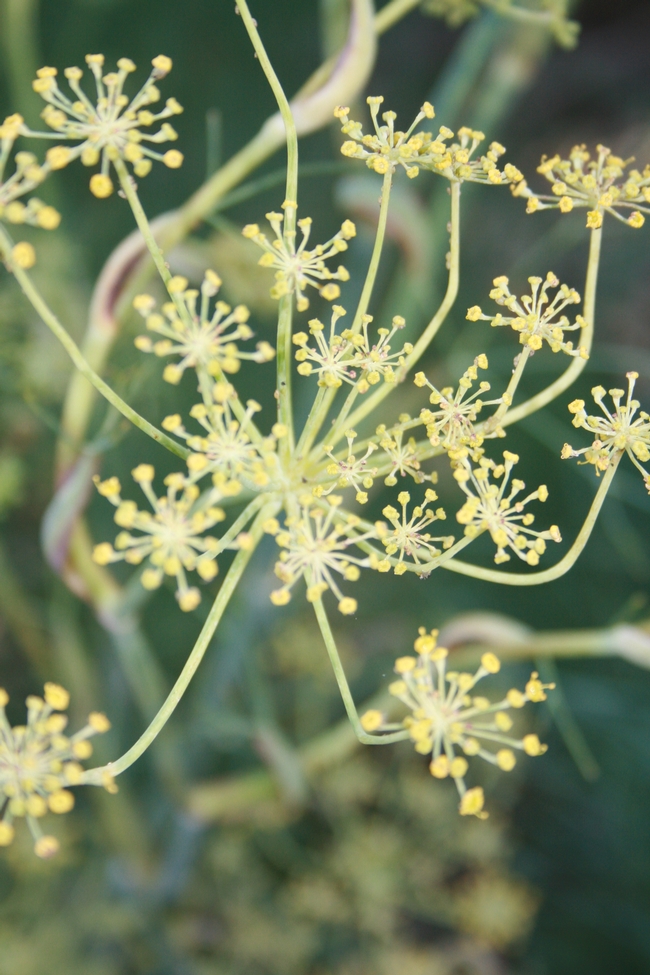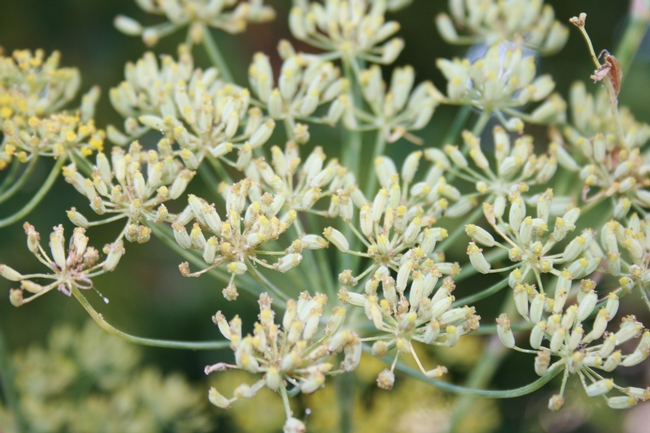By Christine Lampe -
I planted Florence Fennel (aka finnochio) last winter. This is the kind that is supposed to form a large edible bulb-like stem at the base that is eaten as a vegetable. I also planted it the previous year. Neither year has the fennel formed the bulb for me. Not sure what I need to do differently to get the bulb. But meanwhile, I am still getting a lot of value out of my fennel. 
There are other parts of the fennel that are useful.
The leaves or seeds can be used in an herbal infusion (tea). I found a recipe for Pomegranate-Fennel iced tea. Since I had several seeds collected from the previous year, I tried this recipe, and found it quite refreshing, with a very different taste. [See recipe below.]
The feathery fronds have a dill-like flavor with a hint of licorice. They can be used in salads, sauces, and dressings. You can mix finely chopped fennel leaves with cream cheese to use as a spread. The leaves go well with fish and chicken. Or you can braise fish over a bed of dried fennel stems.
The pollen is used as a poor-man’s saffron. Just tap the clusters of yellow flowers onto a plate or bowl to gather the pollen. Use it as you would saffron, to flavor rice, or in Indian-type dishes. I found where you can buy the pollen for $20 per ounce (not so poor-man’s to me), so collecting your own seems worth the bother, though you don’t get much.
Seeds can be used either green or dried. The green seeds are candied to use like after-dinner mints for Indian meals. You can buy them at Indian groceries. I found a recipe for making this candied snack but it involved a lot of exotic ingredients. So I just tried eating the plain green seeds. They have a surprising little burst of sweetness, and just a subtle hint of licorice flavor.
In additional to its culinary uses, fennel makes a great beneficial plant for the garden. It attracts a lot of beneficials. And boy, has it even done so this year. First it attracted a lot of aphids (not beneficial of course, but at least they were attracted away from the other vegetables). I didn’t panic at the sight of all those aphids for usually there is a lag time between them and their predators showing up. And true to expectations, a week or so later, the lady beetles came (first larvae, pupae, and then adults). Assassin bugs, and lacewing eggs followed them. Black swallowtail butterflies are supposed to lay their eggs in fennel, but I haven’t seen any of them yet.
Iced Pomegranate-Fennel Green Tea
SERVINGS: Makes 3 quarts
8 cups water
1/4 cup fennel seeds (green or dried)
8 green-tea bags
1/3 cup honey
1 quart pure pomegranate juice
1/4 cup fresh lemon juice
1 lemon, thinly sliced
1 navel orange, thinly sliced
Bring the water and fennel seeds to a boil. Reduce heat to low and simmer for 20 minutes. Remove from heat, and add the tea bags. Steep for 10 minutes. Strain the tea into a pitcher. Stir in the honey. Let cool, then add juices and citrus slices. Serve over ice.
Click on the small photos below to see the full-size photos.
Attached Images:


